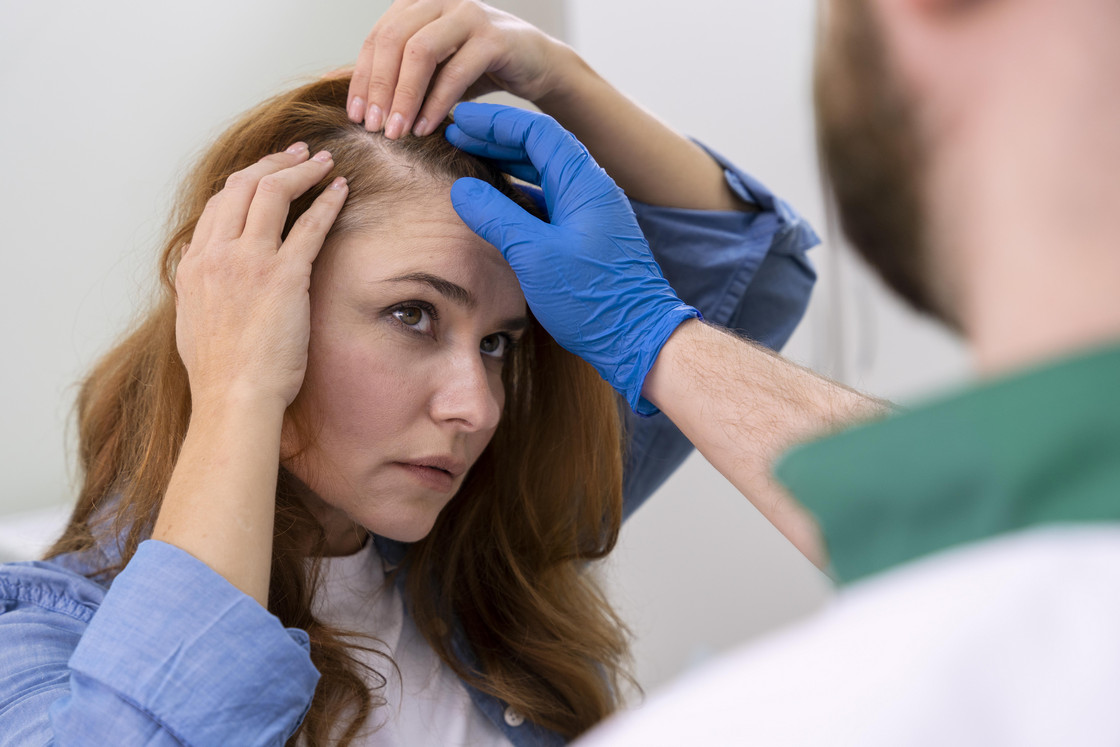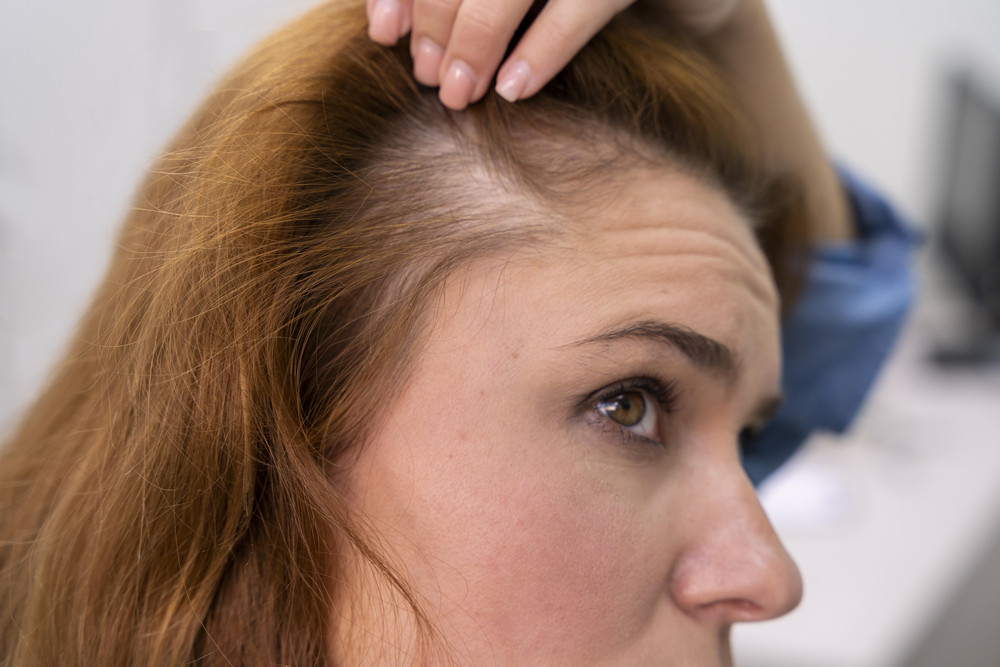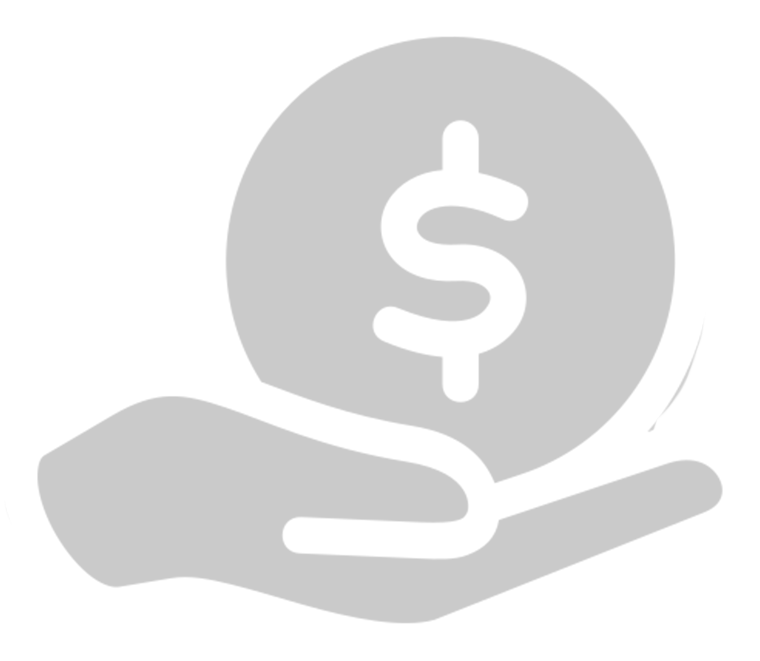Tabla de Contenidos
🧠 What is the medical term for One-sided hair loss?
The medical term for hair loss on one side of the head is unilateral alopecia. “Unilateral” means “on one side,” while “alopecia” refers to hair loss. Unilateral alopecia isn’t a diagnosis but a symptom that may indicate an underlying condition affecting only one side of the scalp or body. The loss of hair on one side of the head can be due to physical, medical, or psychological factors, and its identification is crucial for determining appropriate treatment.
⚠️ What causes one-sided hair loss?
Several conditions and Lifestyle factors can lead to hair loss on one side of the head. Below are the most common causes:
Traction alopecia
Traction Alopecia occurs when hair is pulled tightly repeatedly in the same direction due to certain hairstyles, such as ponytails, braids, or tight buns. If styling habits favor one side, hair thinning can occur only on that side.
Tinea capitis (scalp ringworm):
This fungal infection of the scalp can cause white, itchy patches. If the infection is localized, it will create hair loss on one side of the head.
Trichotillomania
Trichotillomania is a mental health disorder in which people compulsively pull out their hair. Depending on which side the hair is pulled from, it can lead to patchy or one-sided hair loss.
Sleeping patterns
Habitually sleeping on one side of your head can cause friction and damage to hair follicles over time, resulting in localized hair thinning.
Nerve damage or stroke
Damage to the nerves on one side of the head or a history of stroke can disrupt signals to hair follicles, potentially contributing to hair loss.
Scalp injuries or scarring
Injuries, burns, or surgical scars can damage follicles and cause permanent hair loss on one side of the scalp.
Localized alopecia areata
An autoimmune condition where the immune system attacks hair follicles, alopecia areata can sometimes affect just one area of the scalp, leading to one-sided hair loss.
🔍 How is unilateral alopecia diagnosed?
Diagnosing unilateral alopecia involves a thorough physical examination and discussion of your medical history and lifestyle. A dermatologist may perform the following:
- Scalp examination: To observe patterns of hair loss, inflammation, scaling, or scarring
- Pull test: The pull test is just as it sounds, a doctor gently pulls on a small section of hair to see how easily it falls out
- Trichoscopy: A dermatoscopic exam of the scalp and hair to assess follicular health
- Blood tests: : The blood tests are done to find underlying autoimmune diseases, thyroid issues, or nutritional deficiencies
- Fungal culture or biopsy: If a fungal infection or alopecia areata is suspected, samples may be taken for lab analysis

💡 One-sided hair loss treatments
Treatment for hair loss on one side depends on the root cause. Here are common therapies:
Topical treatments
Minoxidil (Rogaine) is widely used for various forms of alopecia, including localized patterns. It stimulates hair regrowth by increasing blood flow to the follicles.
Antifungal medication
If a fungal infection like tinea capitis is the culprit, oral antifungals such as griseofulvin or terbinafine may be prescribed.
Behavioral therapy
For trichotillomania, cognitive behavioral therapy (CBT) is effective in helping individuals control hair-pulling impulses.
Steroid injections
For autoimmune-related hair loss like alopecia areata, corticosteroid injections can reduce inflammation and encourage regrowth.
Laser therapy
Low-level laser therapy (LLLT) can promote hair growth by stimulating cellular activity in hair follicles.
Hair transplant surgery
In cases of scarring or permanent follicular damage, a surgical hair transplant replaces lost hair.
🧴 Post-Treatment hair care
After addressing the cause of hair loss on one side, maintaining healthy hair practices is essential to prevent recurrence and promote regrowth.
- Gentle handling: Avoid tight hairstyles and excessive brushing, especially on the affected side
- Use mild products: Choose sulfate-free shampoos and conditioners to prevent scalp irritation
- Regular scalp massage: Improves circulation and supports follicle health
- Balanced diet: Ensure intake of iron, zinc, biotin, and protein.
- Stress management: Chronic stress contributes to many body issues, including hair loss, so incorporating relaxation techniques like yoga or meditation can be helpful
Hair loss on one side of the head can be distressing, but understanding its underlying causes and seeking timely diagnosis and treatment can lead to positive outcomes. Whether it’s traction alopecia from hairstyles, an autoimmune condition, or a scalp infection, tailored treatment options are available. Maintaining consistent post-treatment care and protecting the health of your scalp are essential steps to achieving long-term hair restoration and balance.
If you need one-sided hair loss treatment or solutions for other hair issues, our expert hair professionals at Hair Fix Mexico have the solution you want at an affordable price. Your journey to a fuller head of hair starts with a free consultation. Call us today and get a head start on fuller hair and improved scalp health!





